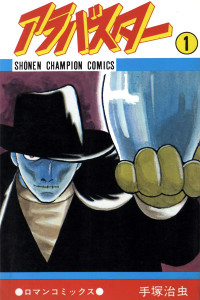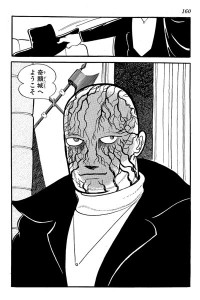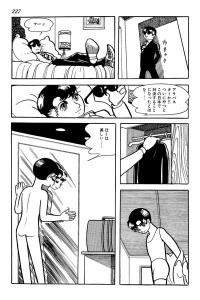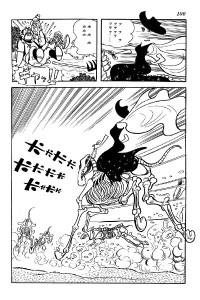Alabaster (Manga)
Also known as アラバスター (Arabastaa)
| English Title: | Alabaster |
| In English? | Yes |
| Japanese Title: | アラバスター Arabastaa |
| Type: | Ongoing Serial |
| Original run: | 1970/12/21 – 1971/06/28 |
| Published in: | Weekly Shonen Champion 週刊少年チャンピオン |
| Published by: | Akita Shoten |
| Volumes: | 2 MT-089 | MT-090 |
Originally serialized in Weekly Shonen Champion, from December 21, 1970 to June 28, 1971, Alabaster (1970-71) is one of Tezuka’s most dark and controversial manga series.
What it’s about
James Block, a handsome, famous and successful black athlete, looses everything when a failed romance releases the homicidal fury pent up inside and he runs his car into a crowd of people. In prison he encounters the mysterious Doctor F, who has invented a ray which can make things invisible. Upon his release, he finds the lab and attempts to make himself invisible, a useful tool for criminal enterprise, but the ray malfunctions, causing him torturous pain and rendering only parts of him invisible, so he now appears as a hideous, vein-striped monster. Instilled by a hatred of all things beautiful, James renames himself Alabaster and sets out to found a criminal gang bent on destroying the beauty of the world.
First he takes revenge on Susan Ross, the woman who rejected him. Although Dr. F’s invisibility ray can turn anything invisible, the process can be lethal to all living things. So, using the F-ray, he kills her and then renders the corpse invisible, ensuring it will never be found.
Alabaster then comes across Ami, Dr. F’s granddaughter, who, due to her grandfather’s experiments, was born invisible. He arranges for her to spring her boyfriend, Genya, and several other young thugs associated with him from prison, and then takes control of the group – treating Ami like a queen because her invisibility appeals to his twisted sense of beauty, and the rest almost like slaves. With his gang in place, Alabaster has them pull a string of jewelry heists – leaving hideous bodies behind.
Alabaster‘s reign of terror soon catches the attention of Rock, a sinister and corrupt FBI agent. As skeletal horses stampede through the countryside, his gang raids homes at random, leaving semi-visible corpses and hideous survivors with their brains and eyeballs visible through transparent faces. In the end, it comes down to a three-way struggle between Kanihei, Ami’s visible brother, Alabaster and Rock – with Ami, being torn in all directions, at the center of it all.
What you should know
The serialization of Alabaster (1970-71) in Weekly Shonen Champion sparked more controversy than just about any of Tezuka’s other works – and an unusual sort of controversy to boot. While Black Jack (1973-83) and other social commentaries often elicited criticism from the medical establishment or other organizations, Alabaster (1970-71) triggered a great volume of angry letters from Tezuka’s diehard fans who were shocked to read a story so filled with evil and devoid of heroes.
Although Tezuka had begun to explore the appeal and charisma of evil in Vampires (1966-69), in Alabaster (1970-71) he seemed to have abandoned the optimistic world of Astro Boy and his other guardians of virtue – which fans had relied upon to challenge and overthrow that evil. Written at a the juxtaposition of Tezuka’s exploration of more mature themes and his own professional financial crisis with the bankruptcy of his animation studio Mushi Productions and the loss of legal rights to many of his own animated creations, Alabaster (1970-71) is bleak.
There is no virtue to be found, as one might expect, in the story of innocent young lovers. Ami, who starts out as a virtuous young girl, is led into crime when Genya persuades her to help him in a jewelry heist to secure money to help his ailing family. After he, and a selection of other young petty thieves, are busted out of jail, they are all forced to aid Alabaster – with Ami eventually ending up as a vicious murderess. Only Ami’s brother, Kanihei, retains any virtue throughout the story, but he’s no hero and can do little more than bear witness to the corruption of Alabaster’s touch.
From the perspective of Tezuka’s Star System, what is really interesting is the absences. Tezuka declined to cast his usual assortment of detectives and policemen. There is no Inspector Geta, Inspector Tawashi or even Shunsaku Ban to bring the criminals to justice. Instead, the forces of law are represented by Rock – a far cry from his “boy detective” roots in Metropolis (1949) or The Adventure of Rock (1952-54). The sadistic FBI agent is every bit as sinister and self-serving as Makube Rokuro was in Vampires (1966-69). Similarly absent are Tezuka’s “usual suspects” of self-serving thugs: Acetylene Lamp, Skunk Kusai, Hamegg, etc. Instead Alabaster is a truly cruel criminal, not working for personal gain but to harm others, with those under him as much prisoners as helpers.
Where you can get it
In 2015, an English-language edition of Alabaster (1970-71) was published as a two-volume set as part of a successful Kickstarter campaign.






